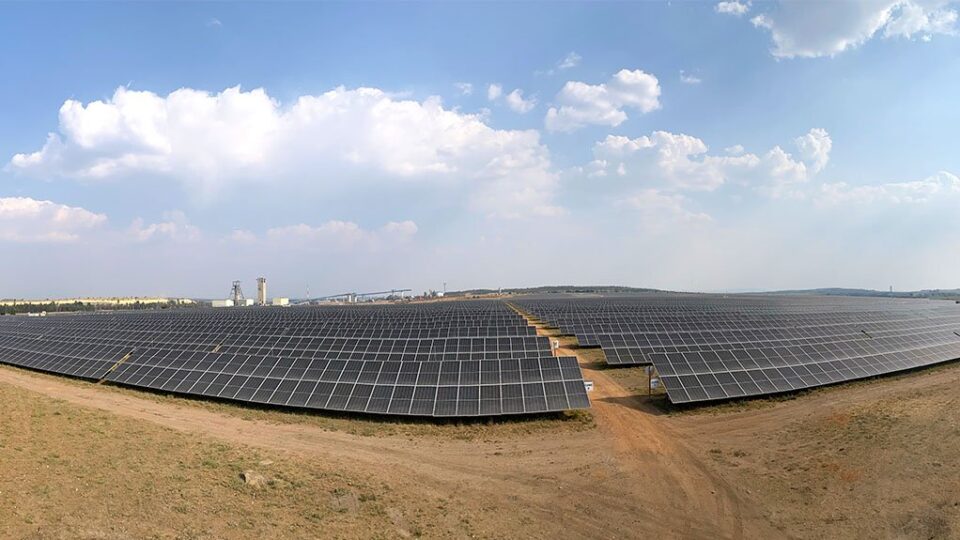The construction of gold miner Gold Fields’ 50 MW Khanyisa solar photovoltaic (PV) plant at its South Deep gold mine was completed in August this year, and Gold Fields executive VP Martin Preece espouses the benefits thereof to Africa-Middle East Mining and Energy News
Such benefits include, mitigating loadshedding, reducing energy costs and reducing the mine’s carbon emissions.
Preece notes that it is fitting that Khanyisa means “Light up”, a name chosen by the people of South Deep.
Preece says the company is pleased with Khanyisa’s output since becoming operational.
“South Deep is using about 450 GWh/y. Khanyisa is going to produce about 103 GWh/y, so just over 20% of our requirements. This is helping us reduce our energy costs by about 25%. In terms of decarbonisation, Khanyisa will help us reduce just over 100 000 t/y of greenhouse gases released from operations.”
He adds that Khanyisa is enabling South Deep to have some measure of “business continuity” amid severe loadshedding in South Africa.
“Generally, when the country is experiencing Stage 4, 5 and 6 loadshedding, the process plant is shut down and material is stockpiled, but at least mining can continue.”
Preece says Gold Fields is “fine tuning” the Khanyisa plant, and matching supply and demand.
The 50 MW Khanyisa plant is configured by joining two 5 MW zones into 10 MW; therefore, Khanyisa is generating five streams of 10 MW.
“What we’re doing now is balancing demand and supply. One stream deals with the shafts and winders, another stream deals with the main fans, another helps with underground infrastructure, and another is for the process plant.”
The fifth stream supplies power to the South Shaft complex to power main fans, refrigeration and pumping operations.
He stresses that the process to construct the plant involved a collaborative approach by building relationships with stakeholders.
Preece also emphasises the impact of the Khanyisa plant on improving business sustainability, thereby enhancing job security for employees.
“Sixty-eight per cent of our employees live in host communities of the mine. By making the business more viable, we ensure we continue paying wages for employees who are going back into these communities, putting their kids through school and building sound societies. We’re also reducing a 50 MW burden on Eskom, that can be retained in the grid and used to keep small, medium-sized and micro-enterprises operational.”
The electrical consultants who performed electrical design work for the Khanyisa plant were engineering firm EHL Group.
Solar energy company Eco Solar Power and local female empowerment company Uzile supplied and installed the solar panels.
Gold Fields is exploring the possibility of offering surplus power to Eskom.
On days when the mine conducts maintenance on its process plant, and the plant does not use any electricity, it would be able to offer surplus power to the utility.
Eskom has suggested two ways by which Gold Fields can feed power back into the grid and the miner is currently evaluating the feasibility of these methods.
Gold Fields is also investigating the use of wind turbines as an alternative source of embedded power generation.
“We’ve got the initial test results. They are very promising, and are about 40% higher than what we require. During the day, the wind turbines would generate surplus energy for us. Putting the surplus power back into the grid is ideal, as batteries for storage are currently expensive and inefficient.
“Gold Fields aims to eventually increase the plant’s capacity to 60 MW as the mine’s power demand increases. That will happen as the mine will be getting deeper in the coming years and will require additional cooling capacity,” says Preece.
An additional 10 000 solar panels have been ordered to boost capacity to 60 MW, but importantly in the short term to allow Gold Fields to reach peak energy generation earlier in the morning, and continue producing for longer.
If the company can prove that wind generation is viable, it will aim to install wind turbines before increasing solar capacity to 60 MW, as the turbines will provide extra megawatts during the day and evening.
An environmental-impact assessment for a wind generation project is under way, with the approval process estimated to be completed at the end of 2023 or early 2024, Preece notes.
“Hopefully, in the future, batteries will have become cheaper and technologies will have improved so that we can consider some storage solutions once all the embedded generation is in place.”
Preece listed Gold Fields’ range of ongoing embedded generation projects for its operations worldwide.
These include a hydro-electrical project that provides 100% of power for its Cerro Corona mine, in Peru, as well as hybrid renewable-energy microgrids for the company’s Agnew, Granny Smith and Gruyere mines, in Western Australia.
Gold Fields will also complete the construction of its Salares Norte mine in Chile, next year, with a solar PV plant added to a fleet of diesel gensets by 2024.
“We’ve made commitments to a 30% net carbon reduction by the group by 2030 and to be carbon neutral by 2050, and we’re on our way to realising these objectives. We’re doing this not only because it’s the right thing to do, but because it also contributes to the bottom line of the business,” he concludes.




